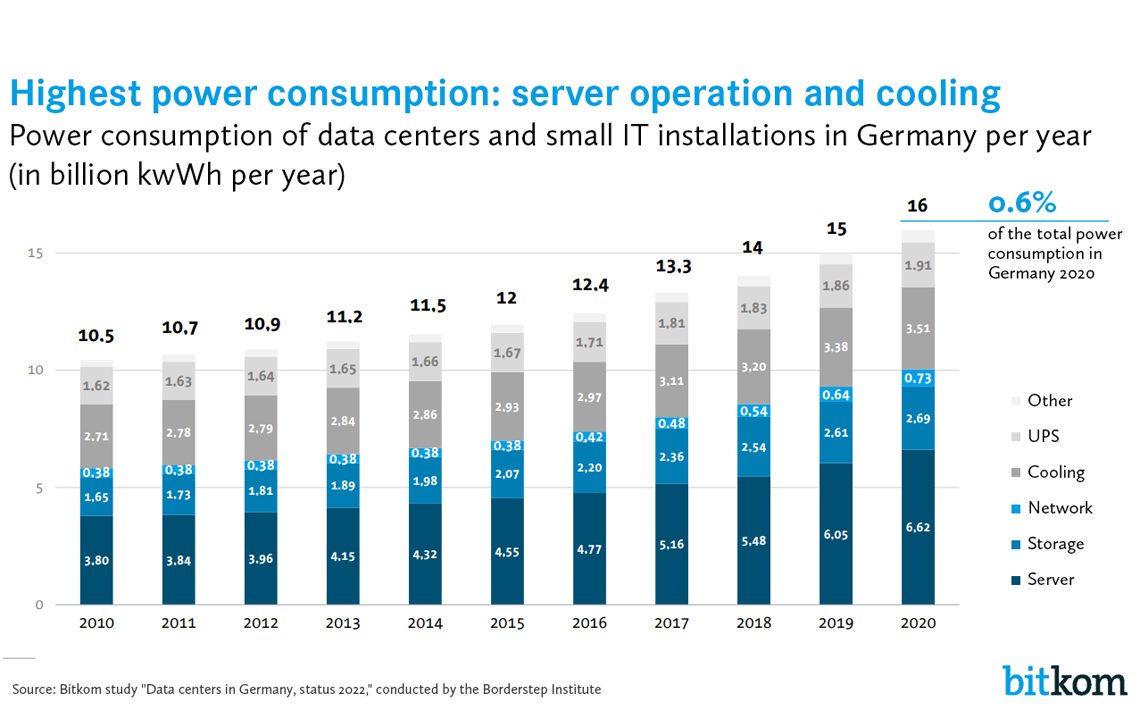We are used to using the internet anywhere and at any time, communicating digitally as part of a remote office or homeschooling, and saving data to maximise its availability. The data needed for this to happen is processed in data centres, the number of which is rising sharply. There are around 50,000 in Germany alone, according to Bitkom. The capacities of German data centres increased by 84 per cent between 2010 and 2020 alone, and are expected to rise by around one third by 2025.

Bitkom study, only available in German: Data centres in Germany, Current market developments, 2022: The energy requirements of data centres in Germany – according to Bitkom, around 22 per cent of the total electricity consumption of data centres is attributable to cooling
Data centres and their energy requirements
Data centres depend on reliable, efficient cooling to function and make full use of their capacity. ‘Energy efficiency is a major issue for data centres because their energy consumption is extremely high. Data centres account for between 1 and 1.5 per cent of the world’s energy consumption. Cooling has a major effect on energy efficiency,’ explains Mathias Layher, Director Sales AC, Marine and Process at BITZER. According to Bitkom, around 22 per cent of the total electricity consumption of data centres is attributable to cooling. This is the largest share after server operation.
Data centres do not take breaks; they have to operate reliably 24 hours a day, seven days a week, and they generate waste heat in the process. Servers cannot perform optimally without consistent moderate temperatures which require constant cooling. This makes the reliability of the refrigeration system an essential factor: the more constant the cooling, the more stable and efficient the processes. Cooling systems are responsible for up to 20 per cent of the overall costs associated with a data centre as they ensure reliable, efficient data centre operation. Modern systems allow for increasingly efficient cooling and take advantage of the waste heat which cooling systems transport away from the server rooms.
BITZER and data centres
‘BITZER provides highly efficient screw and scroll compressors as well as heat exchangers to cool data centres efficiently and make effective use of waste heat,’ says Layher. ‘The products must be extremely reliable. This is always important – all the more so for data centres.’ If, for example, you compare the standard model of the ORBIT scroll compressor from BITZER against the ORBIT+ scroll model from the refrigeration and air conditioning specialist, you will see that the cooling capacity of ORBIT+ compressors with line start permanent magnet motors (LSPM) in air and water cooled systems is between three and five per cent higher than the ORBIT standard model. Moreover, the ORBIT+ scroll compressor boasts a higher seasonal energy efficiency ratio (SEER) that is five to eight per cent higher than the standard model.
An example of how BITZER products can be used in data centres: as one of the first systems with the adiabatic system, the Italian company HiRef S.p.A., which specialises in manufacturing air conditioning systems for areas containing technical hardware and technology, relies on BITZER products. For more information about cooling with the adiabatic system from BITZER and HiRef, visit: HiRef is using screw compressors from BITZER to cool a data centre adiabatically
With screw and scroll compressors forming part of a redundant cooling system, BITZER uses its own products and both branches of compressor technology in the data centre at its headquarters in Sindelfingen. The waste heat from the servers is blown into two heat channels and a heat exchanger uses it to provide heating where it is needed. BITZER is planning to set up an energy management system that will collect all the relevant data and whose efficiency can be measured on the basis of preset key performance indicators. The data centre of the refrigeration and air conditioning specialist was recently certified with the TÜV seal of quality in terms of availability and protective capacity.


